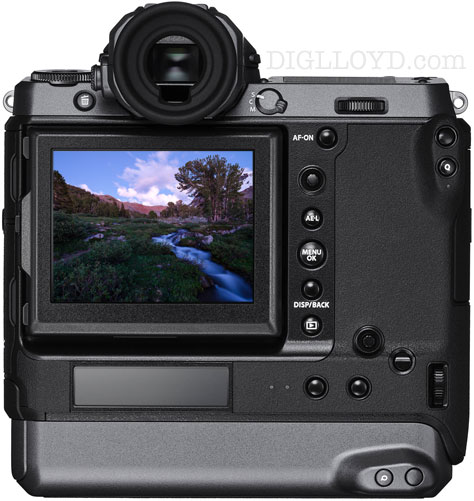Image Quality: Fujifilm GFX100 vs Fujifilm GFX 50S/R
If anyone wonders whether a Fujifilm GFX100 is better than a Fujifilm GFX 50RS, just take a look at the pixels—freedom from moiré, color aliasing, etc. I have not seen any of these ugly 'digital' problems in any of my field shots, whereas the 50S/R are plagued by them. Oversampling is critical to best image quality, and it appears that 100 megapixels via 3.7 micron pixels gets the job done on the 44 X 33mm sensor.

Then take a look at the per pixel acuity at 50 megapixels downsampled from 100MP—there is just no comparison, game, set and match in favor of the GFX100. If you want an ultra-clean totally non-digital 50MP image, shoot the GFX100 and downsample to 50MP (no need to downsample, but doing so demonstrates the point visually vs natively-shot 50MP).
Jason W writes:
I've been looking at and comparing GFX 50 shots against the GFX100 for two weeks and it's exactly as you say. No comparison. It also brings up a controversial point you may or may not agree with, which is even when using a stitch, the per-pixel quality of each original frame still propagates down into the final full stitch.
The GFX 50R/S per pixel quality is a mess, and even comparing stitches, the GFX 100 cohesion is superior. Resolution is better on the stitches of course, but it still feels muddled and crunchy with the GFX 50S. The GFX50 artifacts are so glaring that they often come through even when the images are viewed at smaller sizes. The GFX100 is free of these at any level and this makes them feel more cohesive and complete.
... Comments apply to without Enhance Details, but even with ED, the fine articulation of texture isn't there with the GFX 50S. Looking at brick work and fine lines of ripples on water in different RAW files off the GFX 50, even with ED, it still doesn't draw me in. It's still blocky.
DIGLLOYD: I didn’t express it that way but “crunchy” in particular with the Fujifilm GFX 50S is spot-on. This stems from color aliasing*, color moiré, corruption of actual color due to those two factors, staircasing, plus false detail, all of which accrue from too low a sampling frequency (on a Bayer matrix sensor) relative to most of the subjects I shoot (but also applies to product photography and portraiture). It was a constant pain in the ass to use f/5.6 with the GFX 50S for this reason—sharp and digital looking all too often. It also screws with the quality of stitches since all those effects create “detail” that gets stitched together and combine. Note that the foregoing issues are slightly to significantly reduced by using Adobe Camera Raw Enhance Details—not a cure, but it helps.
The Fujifilm GFX100 makes all that go away and is more natural-looking than any digital camera I have used—period. That is, with the glaring exception of the unnecessary and sad flaw of PDAF banding, when it occurs. There was no damned reason to ruin the image quality (blue sky) of a camera better suited to landscape than any camera in history (so far) with PDAF pixels—Fujifilm trying too hard to make a multi-purpose tool—and worse, it cannot autofocus worth a damn in 100% Live View—when I focus manually in 100% Live View, I can always make it sharper than what AF delivers, which is strange—while soem other cameras get it wrong sometimes by a teeny bit, I’ve never seen this consistently bad behavior. Ironically it is accurate when not zoomed in in Live View.
Yes, the per-pixel quality propagates into a stitch and/or focus stack with a slight loss of micro contrast—unavoidable since pixels must be stretched to mesh properly. This effect is small if excellent shot discipline is used for the best possible match between captures. Or it can be large for quick and dirty work. A light touch of diffraction mitigating sharpening cures it: GIGO (goodness-in = goodness-out or garbage-in = garbage-out).
* I have yet to notice any color aliasing or color moiré issues with the Fujifilm GFX100. Of course I know it can and must occur at the right aperture and frequency of subject detail, and I could presumably produce examples, but the point is that it has not troubled me with any of my field shots, which is what counts. OTOH, check out the amazing freedom from color aliasing in the Siemens chart—quite unusual. So something might be helping at the sensor level.
Dr. S writes:
With all the digital flaws of the GFX 50 seemingly fading away with the new GFx100 when downsampling to 50mp do you think Sony has found a way to apply the new sensor tech/per-pixel quality into their new 61MP sensors for the Sony A7R IV and more-than-likely Nikon Z-whatever? If so, this bodes well for some future cams.
DIGLLOYD: downsampling is not presumed for the discussion above—the GFX100 is better on a per-pixel basis. But when downsampled to 50MP, the GFX100 blows away the 50MP 50S—oversampling cures digital ills. As I understand it, the GFX100 sensor and Sony A7R IV sensor share the same technology, though Fujifilm might have made further efforts with their particular sensor that Sony does not. AFAIK, Nikon Z7 does not use a Sony chip, but maybe a Z8 might.



























